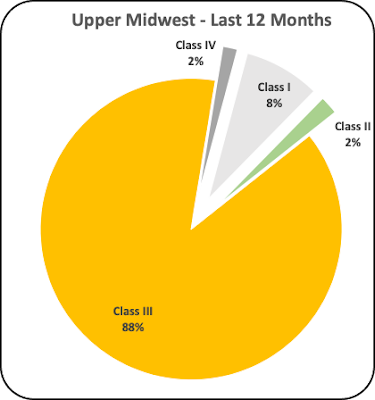The newly announced Agricultural Marketing Service (AMS) prices for milk and components showed a decline in butter and butterfat prices. Butterfat prices are primarily responsible for the 2022 high prices for producer milk. In the October 2022 post to this blog, the fall of butter prices was expected in early 2023. Has the decline already started? This post will review the fundamentals behind butter and butterfat pricing to see if the decline has really started.
In October 2022, butter prices hit another record of $3.19 per pound. In November, the price fell to $2.96 per pound. The increase began in 2021 when butter prices were $1.36 per pound and steadily increased to the record October level (Chart I). The weekly pricing levels reported by AMS show butter pricing increasing over the last four weeks. The weekly pricing reports are consolidated at the end of the month and become the AMS price for that month.
 |
| Chart I - AMS Butter Price |
The price of butterfat is mathematically linked to the price of butter. The AMS price of butter is inversely correlated to the wholesale inventory levels of butter. When there is a lot of inventory, prices are low. When inventories are low, prices are high (Chart II).
 |
| Chart II Butter Inventory and Price |
So where do the butter inventories stand? Chart III shows the cold storage inventory levels of U.S. butter. In October, the most recent data available, inventories have continued their declines as shown by the red line in this chart. October 2022 inventory levels are 20 percent below the October 2020 levels.
 |
| Chart III - Butter Cold Storage Inventories |
Inventory levels are primarily dependent on butter production matching domestic consumption. Consumption has been growing, but production has been declining. Chart IV is a six-year chart of butter production. Butter production is cyclical and has been declining for two years. For the month of October 2022, the monthly U.S. butter production was at the same level as the prior three years, about 161million pounds. For most other months, production has been declining.
 |
| Chart IV - Production of Butter |
 |
| Chart V - California Market Share of Butter Production |
 |
| Chart VI - California Butter Production |
Butter production in the rest of the U.S. shows a steady October volume for the last four years, but the overall decline is obvious (Chart VII).
 | |
|
The losses in U.S. butter production are coming primarily from states other than California and it is widespread. That indicates that to recover inventory levels, U.S. butter production increases must occur in many locations in the U.S. This will not happen quickly.
Domestic per capita consumption of butter has been on a steady rise for a long-time (Chart VIII). Will the consumption levels continue to increase with higher prices? There are two different thoughts on how this might play out.
- One scenario is that butter is a very small part of the food budget. Perhaps consumers will continue to buy butter and accept the higher cost.
- The other scenario is that consumers will look for cost reduction in all grocery items including butter if they are struggling with inflated prices.
 |
| Chart VIII - Per Capita Consumption of Butter |
Putting the puzzle pieces together, what is the mostly likely outcome? It appears that even though AMS butter prices fell in November they may not fall again in the short-term. Production issues have not been resolved enough to rebuild inventories. The low butter inventories will take longer to recover and butter prices will continue to remain high in the near future.
This will be the last post to this blog in 2022. Enjoy the holiday season and celebrate the new year that will hopefully bring cheer and prosperity to all. New posts will be made in early 2023.












































